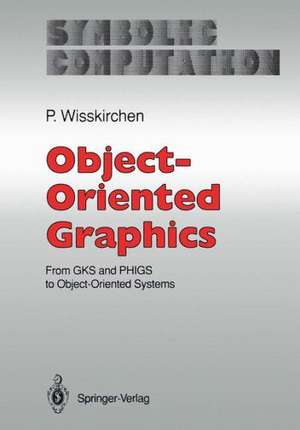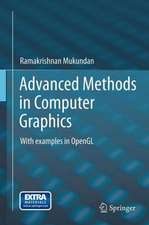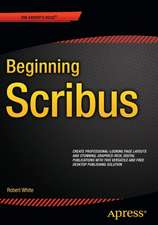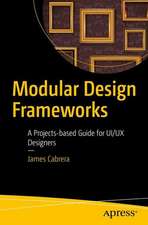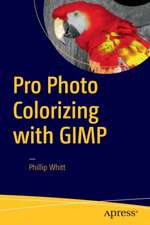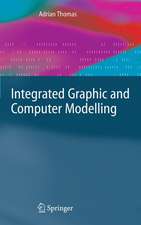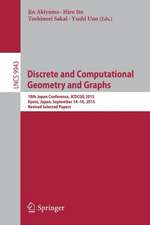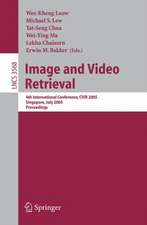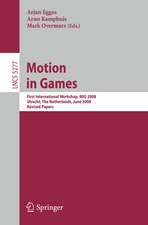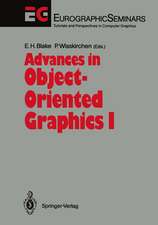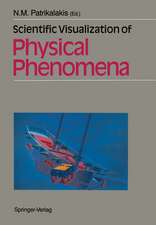Object-Oriented Graphics: From GKS and PHIGS to Object-Oriented Systems: Symbolic Computation
Autor Peter Wisskirchenen Limba Engleză Paperback – 25 dec 2011
Din seria Symbolic Computation
- 20%
 Preț: 350.21 lei
Preț: 350.21 lei - 20%
 Preț: 651.89 lei
Preț: 651.89 lei - 20%
 Preț: 647.61 lei
Preț: 647.61 lei - 20%
 Preț: 649.09 lei
Preț: 649.09 lei - 20%
 Preț: 648.44 lei
Preț: 648.44 lei - 20%
 Preț: 639.35 lei
Preț: 639.35 lei - 20%
 Preț: 653.06 lei
Preț: 653.06 lei - 20%
 Preț: 642.19 lei
Preț: 642.19 lei - 20%
 Preț: 651.09 lei
Preț: 651.09 lei - 20%
 Preț: 659.97 lei
Preț: 659.97 lei - 20%
 Preț: 648.44 lei
Preț: 648.44 lei - 20%
 Preț: 650.27 lei
Preț: 650.27 lei - 20%
 Preț: 646.47 lei
Preț: 646.47 lei -
 Preț: 394.29 lei
Preț: 394.29 lei - 20%
 Preț: 326.46 lei
Preț: 326.46 lei - 20%
 Preț: 342.28 lei
Preț: 342.28 lei - 20%
 Preț: 339.99 lei
Preț: 339.99 lei - 20%
 Preț: 641.01 lei
Preț: 641.01 lei - 20%
 Preț: 657.99 lei
Preț: 657.99 lei - 20%
 Preț: 648.26 lei
Preț: 648.26 lei - 20%
 Preț: 661.47 lei
Preț: 661.47 lei - 15%
 Preț: 638.89 lei
Preț: 638.89 lei - 20%
 Preț: 657.67 lei
Preț: 657.67 lei - 20%
 Preț: 652.73 lei
Preț: 652.73 lei - 20%
 Preț: 330.42 lei
Preț: 330.42 lei - 20%
 Preț: 709.98 lei
Preț: 709.98 lei - 20%
 Preț: 834.69 lei
Preț: 834.69 lei - 20%
 Preț: 656.03 lei
Preț: 656.03 lei - 20%
 Preț: 324.64 lei
Preț: 324.64 lei - 20%
 Preț: 757.48 lei
Preț: 757.48 lei - 20%
 Preț: 355.67 lei
Preț: 355.67 lei - 20%
 Preț: 328.27 lei
Preț: 328.27 lei - 20%
 Preț: 330.24 lei
Preț: 330.24 lei - 20%
 Preț: 342.96 lei
Preț: 342.96 lei - 20%
 Preț: 555.53 lei
Preț: 555.53 lei
Preț: 645.31 lei
Preț vechi: 806.64 lei
-20% Nou
Puncte Express: 968
Preț estimativ în valută:
123.48€ • 128.92$ • 102.20£
123.48€ • 128.92$ • 102.20£
Carte tipărită la comandă
Livrare economică 04-18 aprilie
Preluare comenzi: 021 569.72.76
Specificații
ISBN-13: 9783642842498
ISBN-10: 3642842496
Pagini: 256
Ilustrații: XIII, 236 p. 15 illus.
Dimensiuni: 170 x 242 x 13 mm
Greutate: 0.41 kg
Ediția:Softcover reprint of the original 1st ed. 1990
Editura: Springer Berlin, Heidelberg
Colecția Springer
Seriile Symbolic Computation, Computer Graphics - Systems and Applications
Locul publicării:Berlin, Heidelberg, Germany
ISBN-10: 3642842496
Pagini: 256
Ilustrații: XIII, 236 p. 15 illus.
Dimensiuni: 170 x 242 x 13 mm
Greutate: 0.41 kg
Ediția:Softcover reprint of the original 1st ed. 1990
Editura: Springer Berlin, Heidelberg
Colecția Springer
Seriile Symbolic Computation, Computer Graphics - Systems and Applications
Locul publicării:Berlin, Heidelberg, Germany
Public țintă
ResearchCuprins
1 Introduction.- 1.1 Object-Oriented Languages and Tools.- 1.2 Guidelines for the Design of a Graphics System.- 1.3 Overview.- 2 Object-Oriented Concepts.- 2.1 Objects and Messages.- 2.2 The Class.- 2.3 Message Passing.- 2.4 Inheritance.- 2.5 The Smalltalk-80 Programming Environment.- 2.6 Summary of the Basic Concepts.- 3 Object-Oriented Interface Architecture.- 3.1 Application Framework as Generic Application.- 3.2 The Model-View-Controller Triad.- 4 Smalltalk-80 Graphics Kernel.- 4.1 Output Primitives.- 4.2 Generation and Display of Graphics Objects.- 5 GKS and Object-Oriented System Design.- 5.1 Goals of Standardization.- 5.2 A Short Review of the Main GKS Features.- 5.3 The Structure of a GKS Program.- 5.4 Object-Oriented Modifications.- 5.5 Guidelines for an Object-Oriented Kernel.- 5.6 An Extended Layer Model.- 5.7 Assignment of Attributes.- 5.8 Summary.- 6 Graphics Part Hierarchies.- 6.1 Introduction.- 6.2 Part Hierarchies and Computer Graphics.- 6.3 MacDraw and Part Hierarchies.- 7 PHIGS and Part Hierarchies.- 7.1 Drawbacks of the GKS Model.- 7.2 Motivation for an Extended Functionality.- 7.3 PHIGS Components.- 7.4 Modeling Part Hierarchies in PHIGS.- 8 GEO++.- 8.1 Goals and Motivation.- 8.2 GEO++ Model.- 8.3 Functional Overview by an Example.- 9 Programming Examples.- 9.1 Office Layout Application Programmed With PHIGS.- 9.2 Office Layout Application in GEO++.- 9.3 Comparison of the PHIGS and GEO++ Solution.- 9.4 Pick Object and Assign Attribute.- 9.5 Higher Level Hierarchies.- 9.6 Interactive Editing of a PolyLine.- 9.7 Examination and Comments.- 10 Using Inheritance.- 10.1 Inheritance in GEO++.- 10.2 Alternative Naming.- 10.3 Construction of a Part Hierarchy with Predefined Slots.- 10.4 Using Call-Backs.- 10.5 Accessing Parts.- 11 Prototypes and Delegation.-11.1 What are Prototypes?.- 11.2 Relevance for Computer Graphics.- 11.3 A Prototype Model for GEO++.- 12 GEO++ in Smalltalk-80.- 12.1 Internal Representation of a Group.- 12.2 Implementation of Parts.- 13 Additional Concepts and Tools.- 13.1 Additional Semantical Concepts.- 13.2 Connectivity.- 13.3 Graphics Constraints.- 13.4 Adding Semantics to a Graphics Kernel.- 13.5 Graphics and Hybrid Knowledge Representation.- 13.6 Computer Graphics and Hybrid Systems.- 14 Towards an Object-Oriented Standard?.- 14.1 Chances for an Object-Oriented New API.- 14.2 Requirements and Problems.- 14.3 Guidelines.- References.
